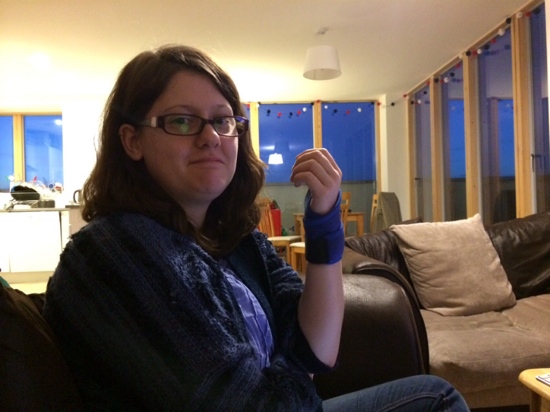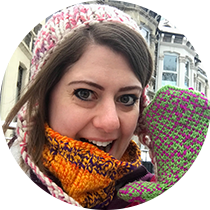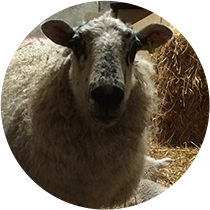I’m afraid to say that hours of knitting the Weasley Sweater have given me a Repetitive Strain Injury (RSI). I’m on knit-rest for a week. That’s right – no knitting for a week!! I thought it was time to address the issue.
If you tell someone your hands hurt because you’ve been knitting too much, they usually have one or both of two reactions:
- How much do you have to knit to get an RSI?!
- Stop knitting. Immediately.
OK so we know I’m crazy and knit a lot; Reaction Number 1 doesn’t bother me. Reaction Number 2 should be enough to tell you how serious RSI can be if those who have previously experienced it can have such an extreme reaction.
Repetitive Strain Injury?
The clue is in the name – repetitive movements strain the structures in your hands and wrists, and you get an injury as damage due to constant identical movement occurs. Sounds fairly harmless, right? Wrong. If ignored, you can damage yourself so badly that it is irreversible. In other words – you would never be able to knit again.
One of the problems with this definition is that it is rather broad – there are a range of symptoms, including specific syndromes such as carpal tunnel that can fall under the bracket of an RSI. I’m not going to go into that, but if you are interested, let me know and I can give you a bit more of the information that I have collected.
How do I know if I have an RSI?
In knitters, focus areas tend to be the wrist or fingers as that is where the majority of the action happens. My research on Ravelry has also indicated that a lot of us ‘hang’ our heads off our necks as we knit, putting a lot of strain on our necks, shoulders and upper backs, and causing injuries there. We are also not helped by the fact that many of us spend a lot of time on computers, gripping our mouse and tapping away at our favourite thread on Ravelry (OK, probably working), with poor posture at the computer.
Typing and clicking are also repetitive movements, and hey, while the majority of the population doesn’t go straight on to another intensive repetitive activity after work, we do. For example, I get up in the morning, knit for an hour on my commute, walk for ten minutes, sit on my computer at work for eight hours, with about three or four short breaks, walk for ten minutes back to the tube station, knit for another hour. That’s ten straight hours, not including the couple of hours I may do in the evening. I know a lot of us do this – we have to consider ourselves a high-risk category in this case, so please do watch out for it.
Repetitive Strain Injury Symptoms
Common symptoms of an RSI include:
- Pain, localised to the area affected – this can be sharp or dull. I have it on the left side of my left wrist and palm, which just ache dully, and in the middle joint of my index, middle and little fingers of that hand, where I get stabbing pains.
- Swelling, stiffness or weakness – I find my rings don’t like coming off and have actually had to stop wearing them recently.
- Tingling or numbness – ever gripped your needles too hard and found you can’t feel the tips of your fingers, then pins & needles as sensation came back? That’s it.
- Sensitivity to temperature changes
- Throbbing or cramp
There are a number of other symptoms that are listed out there, but I’ve tried to condense it into the most common, which cover most bases.
In the beginning stages of the injury, you may notice one or more of these symptoms occasionally, for a few minutes at a time. For example, if you notice as you pop your knitting down to put the kettle on and pick up a choccie biscuit, that your hands feel like they are stuck in the position they were in as you knitted and are reluctant to move. Alternatively, your rings, which always came off quite happily before, suddenly start to be too small for you for a day, then go back to normal.
As you continue your activity – whether it’s in one session where you notice a dull ache and ignore it, or over some days/weeks where you notice symptoms on a regular basis, the effects will fade more slowly, and less each time. You will notice symptoms for some time after you have stopped the activity.
Eventually, you could be stuck with constant symptoms which will simply not go away – at which point the injury is permanent and there is very little that can be done about it without some pretty sturdy medical intervention.
Treatment
The most effective treatment in the early stages is rest. You can take an anti-inflammatory to reduce pain, such as ibuprofen or aspirin. Simple stretches will also help.
If you think you could have an RSI, I reckon you should go see the doctor if you’ve never done so before. You don’t know what you’re dealing with, and the GPs can use their experience to let you know if it is definitely an RSI, or if it is anything worse. A diagnosis is typically made on the basis that the injury occurred following a repetitive injury.
If you do not want to go see a GP but you have pain for more than three weeks, you should definitely go see a doctor. You do not want things to get worse!
Medical interventions can range from simply splinting the area of interest to prevent excess movement and giving your muscles and tendons a break, to physical therapies such as stretching and exercises; steroid injections to anti-inflammatory drugs. The more serious treatments are to be avoided! It’s better to catch early than to have to progress to procedures which can take 3 to 6 months to heal, if at all.
In the case of knitters, hearsay and Ravelry shows that having a break of at least a day where you do not knit at all, in the slightest, not even a single stitch, can help prevent things getting more serious; as soon as you notice any symptoms. My doctor has advised a week as I’ve been sort of ignoring the problem for a little while. I’m almost crying with upset…but I know that if I don’t, I may lose use of my left hand in knitting altogether, so I’m going to stick to it.

Advice from fellow knitters
The advice I have compiled here has come about from browsing a huge number of RSI topics on Ravelry, writing all the little tips I could find that people have found helped, and collating them into the most commonly used remedies. Please, do not think that this is medical advice, because it’s not – it’s simply a collective of experience, and combines treatment and prevention issues.
Needles
Bamboo needles are said to help, with arthritis sufferers often saying this helps them too. Maybe it’s because they’re lighter, or maybe they slide out of your hands less easily so you don’t have to hold onto them as hard? Another common theory is that they retain the heat of your hand and this can be easier to cope with.
Square shaped needles can also be noticeably less painful, as told by Ravellers who have switched from cylindrical needles to square. The only thing I can attribute this to is that you don’t have to grip the needles as hard to stop them rolling! I’m definitely going to try a set.
Circular needles are by far the most mentioned needle-type to help with pain. The weight of the project rests on the lap rather than hanging off the needles on the wrists, which lets you relax a bit more.
Yarn
Different types of yarn make a difference to RSI. This is something I have noticed in the past, noticeably when I was knitting Digger in a cotton yarn. Elastic yarns have been found to strain knitters less – I don’t mean you have to knit with actual elastic, but wool and other fibres with more give can be less hard on the hands.
Many knitters have also found that using a finer gauge means less pain. Your guess is as good as mine as to why this one works!
Knitting Style
Do you knit continental or English? This is an extremely common factor – my search seemed to say that continental was better, but by far the most positive reaction was if you switch between continental and English between projects. This may be because the type of repetitive motion is reduced, so the strain is largely reduced as well.
Monogamous knitters may also be at a disadvantage – having a variety of projects on different needle sizes means that if you start getting tired on one set, you can switch to a different one and vary the way you are using your muscles depending on your needles. I found this fascinating – but a lot of people definitely think it works, and I do have a blanket stashed somewhere on 15 mm’s that I may dig out….
Finally, reducing the amount of moment of your hands can help – I have certainly noticed this as I hold the needles a lot closer to the tips than I used to and the pain has been better.
Tension
Many knitters – especially new knitters or those concentrating on difficult sections of a piece – get extremely tense. This is often seen in fingers, wrists, shoulders and the neck. How do you deal with this?
Our Ravellers find that periodically putting the knitting down, standing up and straightening arms above the head, then giving a good ole shake and roll of the shoulders will help.
To reduce tensions, try to avoid knitting to a deadline, or if you do have a deadline to knit to, approach a session of knitting calmly. Yoga before or after may help! We’ve all done it, and if you must, then taking a break where you knit less intensively for a few days will help your body recover.
Non-knitting activities
An activity that a number of Ravellers has cited as helping is probably one of the easiest you could think of. Just sleep in a wrist brace. I intend to do this myself – scientifically, it is thought to help because you heal while you rest, and the brace keeps your joint still to help prevent excessive movement.
Conclusion: RSI is a serious problem.
All of the above applies to many different repetitive motions, from computer use to music instrument playing – obviously specific treatments for knitters are in this article, but the general advice works for everyone. While I was researching this issue on Ravelry, I found a thread that I myself had written 15 months ago, commenting “I think I’ve been knitting too much – I have sore hands from a huge knitting binge over the last few days”.
At this stage, I feel a fool, and am determined to learn from my previous mistakes, and not repeat my stubborness. I hope you can learn from me, if you have not suffered from RSI before, because it’s no picnic!
I would welcome any thoughts and comments from you. I am not a doctor, and while I feel fairly certain that everything I have written is sound, please let me know if I am mistaken in any fact or detail.
Much love,
Corrie xx
Edit added 12/02/2014: have had a lot of responses to this and intend to do another post on ways to relieve the discomfort of RSI once you have actually got it – standby!
Directly quoted sources:
Amongst a number of others to verify the information, and extensive use of Ravelry to identify where and how the symptoms manifest themselves, and what helps. (I had to use up the time where I wasn’t knitting doing something and if we are honest…nobody ever needs an excuse to surf Ravelry. Right?)
Checked by Dr OJ Ralley BSc MBChB.









Great post – and a really useful reminder. For myself, I had carpal tunnel surgery years ago (down to work + knitting, and not something to undergo lightly), but have more recently had terrible problems with recurring tendonitis, aka trigger finger/thumb. One of my docs mentioned that the scar tissue from the old surgery could well be a factor – so there’s another reason not to let RSI get to the point at which surgery is necessary….
That sounds awful, I hope it settles down!
Fab post Corrie. I suffer from RSI from too much crochet and whilst it is just about under control I still have to be really careful. Please please rest rest and rest-even if it takes a month! I started crocheting again too soon and I ended up in a worse position than I was at the beginning. Best of luck and hope you get well super fast x
I really had to stop myself from picking it up last night! So hard to keep restrained. Never mind, feeling a bit better today!
Rest up and heal! I bet the finer gauge bit is because you use smaller movements with thinner yarn and needles. Switching up projects is good, too, but for this week just let yourself rest.
That sounds sensible! Will be good, promise!
I’m so sorry about your injury! :( Sending healing thoughts your way, and hope you manage to get back to your knitting before the Games are over. Watch lots of Olympics for us!
Thank you! I am watching ALL the Olympics, my housemates think I’m crazy.
What a nuisance! I hope the rest works and means that you can pick up your needles and knit again soon :)
I’m already feeling so much better so hopefully by next week things will be peachy!
So sorry you are dealing with this right now. I am in the same boat. I just finished a week of prednisone and now with necessary snow shoveling my hand has swollen again and I can’t get my wedding band on. I know rest is needed but I think I will be making a trip to a hand specialist. Hope you feel better soon and can return to your knitting.
Thank you, I met someone last night who is an osteopath and she was really lovely and gave me some good tips. I’m struggling to keep off the knitting – I intend to do some sewing this weekend to make up for it!
Hope your hand gets better with this week of rest. Your article brings together some very interesting points on something I guess, we all know or fear. A good (yet scary) thought is the thing about typing away on the computer for 8 hours or so and then knitting before and after, what I do as well. So I guess I should be resting a bit too, because in addition to that I can feel the first sights of RSI I have weak wrists. The joints tend to come apart every now and then, causing pain. There is nothing you can do about it but resting a bit. Maybe I leave my knitting at home when I go visit my parents at the weekend… :-(
Isn’t it just heart-breaking? Three days of rest have really helped so I’m sure this weekend will be the final step :)
I’ve had trigger thum and De Quervains- splints, ice, 4 cortisone shots in various spots,
etc. Got a spinning wheel as a gift cuz I used to spin years ago. I’m worried! Trying to do all that sensible preventative stuff both thumbs began to hurt. One at night!! I’m m wondering whether I should drop spinning before I get addicted to it. Not worth causing more pain🙁I’m 61 so you know these. Dash of osteoarthritis too. Thoughts?
I would go with everything is fine in moderation! As long as you don’t overdo it and are sensible, it should be fine – maybe set a timer when you start so that you know when you have to finish? And mix up wheel spinning with spindle spinning because the actions are different. If all else fails, I would visit a doctor before deciding to give up – they may have better advice that doesn’t force you to give up something you love.
Hello!
I am currently in the very same boat as you were when you wrote this blog years ago…pretty sure I have RSI in my wrist. I’m taking a week off of knitting (torture) and I’m freaking out that it won’t be enough! Did yours resolve after the week of rest? I’m on day two of no knitting and it’s still bothering me. I’m also icing and sleeping in a brace.
I’ve made a pact with myself to behave and not binge knit anymore/ take breaks / be overall smarter about my knitting health if only I can get my wrist to stop hurting!!
Just curious about your outcome! Perhaps you have an update blog, I just didn’t see it. Thanks!